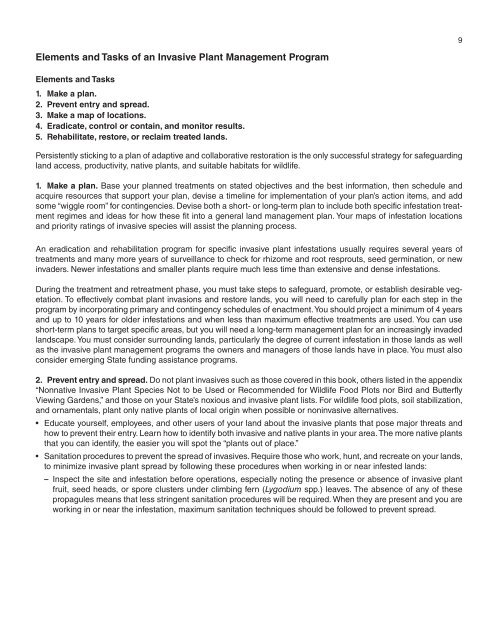A Management Guide for Invasive Plants in Southern Forests James ...
A Management Guide for Invasive Plants in Southern Forests James ...
A Management Guide for Invasive Plants in Southern Forests James ...
- No tags were found...
Create successful ePaper yourself
Turn your PDF publications into a flip-book with our unique Google optimized e-Paper software.
9Elements and Tasks of an <strong>Invasive</strong> Plant <strong>Management</strong> ProgramElements and Tasks1. Make a plan.2. Prevent entry and spread.3. Make a map of locations.4. Eradicate, control or conta<strong>in</strong>, and monitor results.5. Rehabilitate, restore, or reclaim treated lands.Persistently stick<strong>in</strong>g to a plan of adaptive and collaborative restoration is the only successful strategy <strong>for</strong> safeguard<strong>in</strong>gland access, productivity, native plants, and suitable habitats <strong>for</strong> wildlife.1. Make a plan. Base your planned treatments on stated objectives and the best <strong>in</strong><strong>for</strong>mation, then schedule andacquire resources that support your plan, devise a timel<strong>in</strong>e <strong>for</strong> implementation of your plan’s action items, and addsome “wiggle room” <strong>for</strong> cont<strong>in</strong>gencies. Devise both a short- or long-term plan to <strong>in</strong>clude both specific <strong>in</strong>festation treatmentregimes and ideas <strong>for</strong> how these fit <strong>in</strong>to a general land management plan. Your maps of <strong>in</strong>festation locationsand priority rat<strong>in</strong>gs of <strong>in</strong>vasive species will assist the plann<strong>in</strong>g process.An eradication and rehabilitation program <strong>for</strong> specific <strong>in</strong>vasive plant <strong>in</strong>festations usually requires several years oftreatments and many more years of surveillance to check <strong>for</strong> rhizome and root resprouts, seed germ<strong>in</strong>ation, or new<strong>in</strong>vaders. Newer <strong>in</strong>festations and smaller plants require much less time than extensive and dense <strong>in</strong>festations.Dur<strong>in</strong>g the treatment and retreatment phase, you must take steps to safeguard, promote, or establish desirable vegetation.To effectively combat plant <strong>in</strong>vasions and restore lands, you will need to carefully plan <strong>for</strong> each step <strong>in</strong> theprogram by <strong>in</strong>corporat<strong>in</strong>g primary and cont<strong>in</strong>gency schedules of enactment. You should project a m<strong>in</strong>imum of 4 yearsand up to 10 years <strong>for</strong> older <strong>in</strong>festations and when less than maximum effective treatments are used. You can useshort-term plans to target specific areas, but you will need a long-term management plan <strong>for</strong> an <strong>in</strong>creas<strong>in</strong>gly <strong>in</strong>vadedlandscape. You must consider surround<strong>in</strong>g lands, particularly the degree of current <strong>in</strong>festation <strong>in</strong> those lands as wellas the <strong>in</strong>vasive plant management programs the owners and managers of those lands have <strong>in</strong> place. You must alsoconsider emerg<strong>in</strong>g State fund<strong>in</strong>g assistance programs.2. Prevent entry and spread. Do not plant <strong>in</strong>vasives such as those covered <strong>in</strong> this book, others listed <strong>in</strong> the appendix“Nonnative <strong>Invasive</strong> Plant Species Not to be Used or Recommended <strong>for</strong> Wildlife Food Plots nor Bird and ButterflyView<strong>in</strong>g Gardens,” and those on your State’s noxious and <strong>in</strong>vasive plant lists. For wildlife food plots, soil stabilization,and ornamentals, plant only native plants of local orig<strong>in</strong> when possible or non<strong>in</strong>vasive alternatives.• Educate yourself, employees, and other users of your land about the <strong>in</strong>vasive plants that pose major threats andhow to prevent their entry. Learn how to identify both <strong>in</strong>vasive and native plants <strong>in</strong> your area. The more native plantsthat you can identify, the easier you will spot the “plants out of place.”• Sanitation procedures to prevent the spread of <strong>in</strong>vasives. Require those who work, hunt, and recreate on your lands,to m<strong>in</strong>imize <strong>in</strong>vasive plant spread by follow<strong>in</strong>g these procedures when work<strong>in</strong>g <strong>in</strong> or near <strong>in</strong>fested lands:Inspect the site and <strong>in</strong>festation be<strong>for</strong>e operations, especially not<strong>in</strong>g the presence or absence of <strong>in</strong>vasive plantfruit, seed heads, or spore clusters under climb<strong>in</strong>g fern (Lygodium spp.) leaves. The absence of any of thesepropagules means that less str<strong>in</strong>gent sanitation procedures will be required. When they are present and you arework<strong>in</strong>g <strong>in</strong> or near the <strong>in</strong>festation, maximum sanitation techniques should be followed to prevent spread.
















